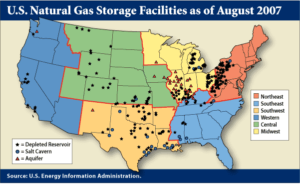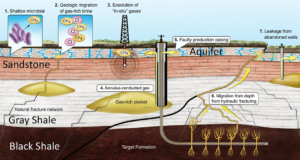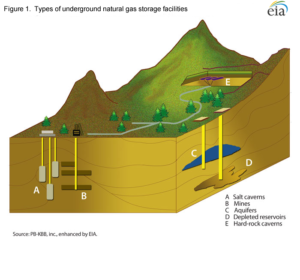By Jacquelyn Potter
Jacquelyn Potter has an MS in Biology and serves on the Executive Committee of the Sierra Club Prairie Group. Her environmental interests range from water and air quality issues to land and wildlife issues.
Water is essential for life, and as drought and desertification have increased, it is projected that major conflicts in future years will be over water. In 2010, the United Nations adopted Resolution 64/292, recognizing “the right to safe and clean drinking water as a human right.” Water rights are often thought of in terms of scarcity or quantity. Visions of armed guards patrolling water sources in the Middle East or public shaming during the California drought come to mind. In such cases, the right to water sounds good until one tries to make good on it without harming one’s neighbor, and without help from nature. If an area is naturally scarce in water, equitable solutions are few, regardless of what we believe is a “right.” And the idea of artificially shipping or pumping water where it doesn’t naturally occur (e.g. the California Water Project) inevitably hastens water scarcity in source areas. The most sustainable way to deal with water scarcity is by respecting natural limitations and living responsibly within those limits. Although there have been improvements in the public use of water (water conservation initiatives and self-enforced water limits), consumption and pollution by industry continues. For example, in California in 2015, the fracking industry used nearly 70 million gallons. Remember, California is a semi-arid state with a history of water disputes that was, at that time, in the grip of a multi-year drought.
But what about areas where water seems plentiful? Should we worry about water rights in such areas? After all, such areas can afford to supply a growing population and many industries, right? When looking at rates of usage, one gets a clearer picture of the inflated situation. For example, Pennsylvania and Illinois, both thought “water rich,” have millions of gallons withdrawn daily, and billions yearly, by industry (especially thermoelectric – oil, coal, gas). But proponents argue that the water is returned back to the environment, so no harm done, right? This is the standard logic behind attitudes on industrial scale water use. But something else needs to be considered: that is, water isn’t simply used by industry and replenished in the same condition it was removed. It is often tainted by industrial use, even when supposed safeguard procedures are in place. So although water scarcity or quantity may seem less a concern in such states, the issue of concern that remains is water quality.
Just because Illinois is gifted with substantial sources of fresh groundwater doesn’t mean we should squander it or allow industrial contamination. Illinois water rights laws include the Water Use Act of 1983, that clarified previous groundwater law, and the federal Safe Drinking Water Act, encompassing the Illinois Groundwater Protection Act, which protects groundwater as a natural and public source, with special provisions for drinking water wells. Recently, water rights have come to the forefront in Champaign County, due to contamination of our Mahomet Aquifer by Peoples Gas. Peoples Gas owns an underground natural gas storage facility, and one of its wells leaked gas into the aquifer. According to Peoples Gas, the leak was discovered when an employee noticed gas on the ground near one of its wells, but it took approximately two weeks before it was sealed. It is unknown how long the leak continued unnoticed or how much gas leaked into the aquifer and surrounding soil during that time. The gas storage underneath the Mahomet Aquifer is in an injection well, stored in natural formations near Mahomet about 4,000 feet underground. A quick search on the subject shows that leaks from injection wells are quite common, mostly due to structural failures (e.g. fractures in surrounding rock). Therefore, the same rule as for pipelines – that it’s not a question of if it will burst, but when – can be applied to injection well gas storage. Is gas leakage a danger when it contaminates an aquifer? Yes. The natural gas is mostly methane, which dissipates from water but collects in enclosed spaces. Risks from contamination include soil damage, explosions, fires, and the health risks of asphyxiation, rashes, nausea and nosebleeds. The contaminated water is unusable. It wasn’t until April, when a homeowner reached out to the Illinois Department of Public Health, that the state was notified. In recent months, Spiros Law took on the case for affected residents. The Illinois Department of Natural Resources issued a Notice of Violation to Peoples Gas for months of unregulated venting, and Peoples Gas responded by proposing disposal of the contaminated water by dumping it on the ground. This plan was deemed unacceptable, and so they installed enormous tanks (thousands of gallons) to hold it until it can be emptied into the Urbana-Champaign Sanitary District (via a permit issued in October). Therefore, the water contaminated with natural gas will go into a cesspool of other chemicals en route (outgassing and synergistic effects anyone?), be processed and then released right back into waterways. Senator Chapin Rose referred the case to the Illinois Attorney General’s Office, and Attorney General Lisa Madigan filed suit against Peoples Gas for contamination of Mahomet Aquifer, impacting five residential wells (although recent developments suggest more wells have been impacted). Questions have been raised regarding the culpability of Peoples Gas as to oversight of the wells, mishandling of the leak, and lack of responsibility in not warning the public and state agencies.
The Mahomet Aquifer supplies over 100 million gallons of water per day to over 850,000 people. It is designated a Sole-Source Aquifer, meaning it supplies at least 50 percent of the drinking water for its area, with no alternative sources if contaminated. It is a semi-confined aquifer, connected to surface water in specific areas (e.g. the Sangamon River) that recharge it. Therefore, not only does the aquifer need protection, but the waterways that recharge it do as well. Although restoration of Clean Water Act protections for Illinois streams was a good start, there must be stronger restrictions on industry seeking to move or store products (e.g. oil or natural gas) above, across or underneath aquifers, perhaps an outright ban, as spills and leaks are more the rule than exceptions. If so many are dependent upon the aquifer and surface waters that recharge it, then how is it the right of the few over the many to over-exploit and pollute? Contamination of water and avoidance of culpability by industrial interests are direct affronts to the basic human right to safe, clean drinking water under the UN Resolution and Illinois’ own Groundwater Protection Act. Maintaining water quality (preserving what is naturally there), is where water rights law is wisely applied.
When delving into water rights, there are obvious culprits, and when one sees figures of millions of gallons withdrawn per day and cases of flammable or poisoned water, it is easy to point fingers; however, we must remember what is driving these industries: demand. Our fingers might as well be pointing at ourselves. This does not excuse industry responsibility, but the truth is that real change and preservation of quantity and quality of water sources will only come when we get away from wasteful and pollutive industries, turn towards sustainable clean energy, and learn to live at sustainable levels of consumption within the natural limitations of our land and water sources.





